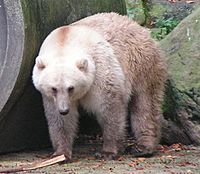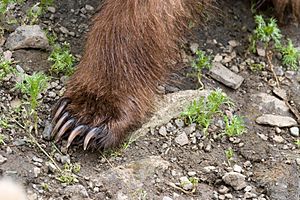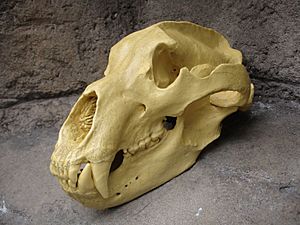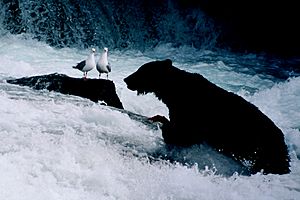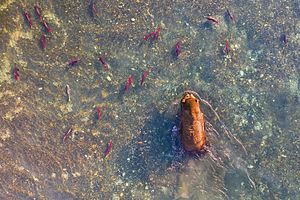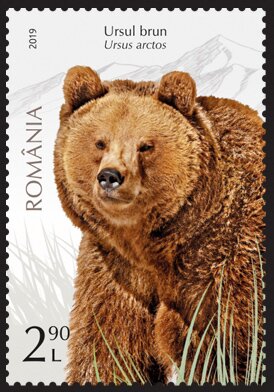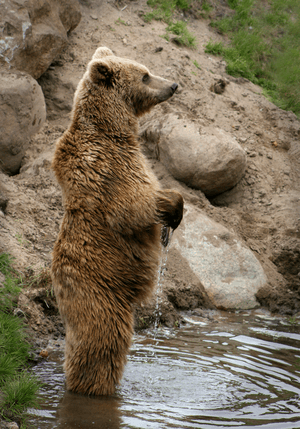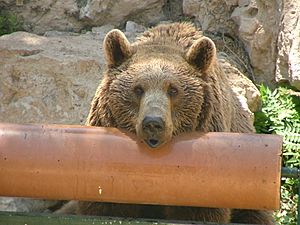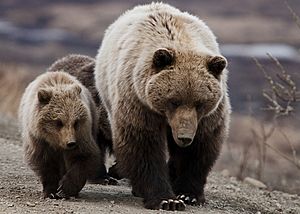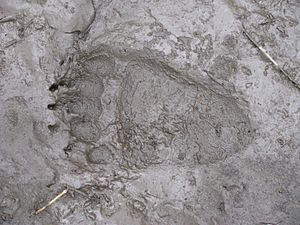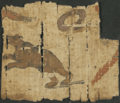Brown bear facts for kids
Quick facts for kids Brown bearTemporal range: Middle Pleistocene-Holocene
|
|
|---|---|
 |
|
| Brown bear (U. arctos) in Hallo Bay, Katmai National Park, Alaska | |
| Conservation status | |
| Scientific classification | |
| Kingdom: | |
| Class: | |
| Order: | |
| Family: | |
| Genus: | |
| Binomial name | |
| Ursus arctos Linnaeus, 1758
|
|
 |
|
| Brown bear range map | |
The brown bear (Ursus arctos) is a very large bear found across many parts of northern Eurasia and North America. While it's not as big as a polar bear, it is the largest meat-eating animal that lives only on land. There are several different types, called subspecies, of brown bears.
Even though the places where brown bears live have gotten smaller, they are still listed as a species of "least concern" by the IUCN. This means they are not currently in danger of disappearing. There are about 200,000 brown bears in total. As of 2012, the brown bear and the American black bear were the only bear species not considered threatened by the IUCN.
However, some brown bear subspecies in southern Asia are in great danger. The smallest one, the Himalayan brown bear, is critically endangered. It lives in only 2% of its original home. Poachers hunt it for its body parts. In central Italy, there are only about 30 to 40 Marsican brown bears left.
Brown bears live in many places, including parts of Russia, Central Asia, China, Canada, and the United States (mostly Alaska). You can also find them in Scandinavia and the Carpathian region, especially Romania. They are also in Anatolia and the Caucasus. The brown bear is an important animal in several European countries. It is the most widespread bear species in the world.
Brown bears are omnivores, meaning they eat both plants and animals. They are also apex predators, which means they are at the top of their food chain. They eat berries, apples, honey, fish, insects, worms, nuts, grasses, leaves, and dead animals (called carrion). They also hunt rodents, rabbits, and even larger animals like deer, moose, reindeer, bison, and sheep.
Contents
How Brown Bears Evolved
Scientists believe brown bears developed from an older bear called Ursus etruscus. The oldest brown bear fossils, found in China, are about 0.5 million years old. Brown bears arrived in Europe around 250,000 years ago and in North Africa soon after. During the Ice Age, brown bear fossils were common in the British Isles. It's thought they were better at surviving than cave bears there.
Brown bears first came to Alaska about 100,000 years ago. However, they didn't move further south until about 13,000 years ago. This might be because a much larger bear, the Arctodus simus, was still around. Once that bear died out, brown bears could spread more easily.
Different Types of Brown Bears
As of 2005, scientists recognize 16 different types, or subspecies, of brown bears. Here are some of them:
| Subspecies Name | Image | Where They Live | What They Look Like |
|---|---|---|---|
| Ursus arctos arctos – Eurasian brown bear |  |
Europe, Caucasus, Siberia (except the east), and Mongolia | Usually dark-colored, but sometimes light. They have dark claws. Siberian Eurasian browns are larger because they are hunted less. In Europe, they mostly live in forests. |
| Ursus arctos beringianus – Kamchatka brown bear |  |
Kamchatka Peninsula and Paramushir Island | A very large, dark bear. Lighter colors are less common than in other types. They have dark claws. |
| Ursus arctos collaris – East Siberian brown bear |  |
East Siberia from the Yenisei River to the Altai Mountains, also northern Mongolia | Mostly dark. They are between the size of the Eurasian and Kamchatka brown bears, with a larger head. |
| Ursus arctos horribilis – Grizzly bear |  |
Western Canada, Alaska, and the northwestern United States. They used to live in the Great Plains. | Grizzlies have medium to dark brown fur with gray tips, making them look "grizzled." They are smaller than coastal bears. They can live in many places, from forests to grasslands. |
| Ursus arctos isabellinus – Himalayan brown bear | 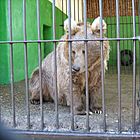 |
Nepal, Pakistan, and Northern India | This bear has reddish-brown or sandy fur. It is smaller than most other brown bears in Asia. |
| Ursus arctos lasiotus – Ussuri brown bear |  |
Southern Kuril Islands, Sakhalin, Maritime territory, and the Ussuri/Amur river region in Russia. Also northeastern Heilongjiang in China, and Hokkaidō, Japan. | This bear is thought to be the ancestor of the Grizzly bear. |
| Ursus arctos middendorffi – Kodiak bear | 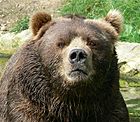 |
Kodiak, Afognak, Shuyak Islands (Alaska) | This is the largest type of brown bear. Other coastal brown bears can also grow very big. |
| Ursus arctos pruinosus – Tibetan blue bear |  |
Western China and Tibet | A medium-sized bear with long, shaggy fur. Colors can be dark, light, or in-between. They often have lighter fur around their neck, like a "collar." |
| Ursus arctos syriacus – Syrian brown bear | 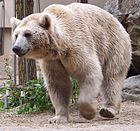 |
Trans-Caucasus, Syria, Iraq, Turkey (Asia Minor), Iran, Afghanistan, western Himalayas, and the Pamir-Alai and Tien Shan mountains. | This is a light-colored, small to medium-sized bear with light claws. |
Bear Hybrids: Pizzly Bears!
A Grizzly–polar bear hybrid is a rare mix between a brown bear and a polar bear. It's sometimes called a pizzly bear or grolar bear. These hybrids have been seen both in zoos and in the wild. In 2006, scientists confirmed a wild hybrid after testing the DNA of a strange-looking bear shot in the Canadian arctic.
What Do Brown Bears Look Like?
When fully grown, brown bears are usually about 5 to 7 feet long. They can stand almost 9 feet tall on their hind legs!
Brown bears have very long, curved claws. The claws on their front paws are longer than those on their back paws. They can be about 2 to 4 inches long along the curve, sometimes even 3 to 4 inches. Their claws are usually dark with a light tip, but some bears have completely light claws. Brown bear claws are longer and straighter than those of American black bears. They are also blunt, not sharp like a black bear's claws.
Brown bears have very strong teeth. Even with powerful jaws, they can't break large bones as easily as animals like spotted hyenas.
Their fur is long and thick, with a bit of a mane (longer fur) on the back of their neck. In India, brown bears can be reddish with silver tips. In China, some are two-colored, with a yellow-brown or whitish "cape" across their shoulders. North American grizzlies can range from very dark brown (almost black) to cream (almost white) or yellowish-brown. Their black hairs often have white tips. Their winter fur is very thick and long, especially in colder places, and can be about 4 to 5 inches long at the withers (the highest part of the back). The winter fur is thin but feels rough. Their summer fur is much shorter and thinner, and its length and thickness change depending on where the bear lives.
Where Do Brown Bears Live?
There are about 200,000 brown bears worldwide. The largest groups live in Russia (120,000), the United States (32,500), and Canada (21,750). About 95% of brown bears in the U.S. live in Alaska. In the lower 48 states, their numbers are slowly growing again in the Rockies and western Great Plains. The last Mexican brown bear was shot in 1960.
In Europe, there are about 14,000 brown bears living in small, separate groups. They range from Spain in the west to Russia in the east. They are also found from Sweden and Finland in the north to Romania, Bulgaria, Slovakia, Slovenia, and Greece in the south. Brown bears are no longer found in the British Isles. They are very rare in France and Spain, and struggling in most of Central Europe.
Romania has the largest brown bear population in Europe outside of Russia, with an estimated 4,500 to 5,000 bears. However, their numbers are decreasing due to too much hunting. There are also smaller groups in the Carpathian Mountains in Ukraine, Slovakia, and Poland. The total Carpathian population is about 8,000 bears. Northern Europe has a large bear population, with about 2,500 in Sweden, 1,600 in Finland, 700 in Estonia, and 70 in Norway. Another large group of 2,500–3,000 brown bears lives in the Dinaric-Pindos region (Balkans). This group spreads across northeast Italy, Slovenia, Croatia, Bosnia and Herzegovina, Serbia, Montenegro, Macedonia, Albania, Bulgaria, and Greece.
Brown bears used to live in Asia, the Atlas Mountains in Africa, Europe, and North America. Now, they are extinct in some areas, and their populations have dropped a lot in others. They prefer open areas, often in mountains.
In Alaska, brown bears live east through the Yukon and Northwest Territories, and south through British Columbia and western Alberta. Small groups also live in the Greater Yellowstone Ecosystem in northwest Wyoming (about 600 bears) and other areas in Montana, Idaho, and Washington. These groups are separated, which makes it hard for bears to mix and share genes. This is a big challenge for the future of grizzly bears in the United States.
In Asia, brown bears are found in most of Russia, parts of the Middle East, and a small area of Manchuria in China. They also live on the island of Hokkaidō in Japan, western China, and parts of North Korea, Afghanistan, and India.
The brown bear population in the Pyrenees mountains between France and Spain is very small, with only about 14 to 18 bears. There aren't enough females. So, in 2006, female bears from Slovenia were released there to help the population grow. This happened despite protests from French farmers.
A small group of brown bears (Ursus arctos marsicanus) still lives in central Italy (Apennine mountains, Abruzzo and Latium). There are no more than 70 of them. They are protected by strict laws, but human presence in the area still puts them at risk.
In Arctic areas, brown bears are finding more places to live. The warming of that region allows them to move further north. This used to be only polar bear territory. In other areas, losing their habitat is the main reason brown bears are endangered, followed by hunting.
North American brown bears, also known as grizzly bears, seem to like open areas. However, in Eurasia, they mostly live in dense forests. It's thought that the Eurasian bears who came to America were used to living in tundra (a treeless plain). This is supported by brown bears in the Chukotka Peninsula in Asia, who live year-round in lowland tundra, just like their North American relatives.
Brown Bear Behavior
Brown bears are mostly active at night. In the summer, they gain up to 400 pounds (180 kg) of fat. They use this fat to survive the winter, when they become very sleepy. They don't truly hibernate like some animals, and can wake up easily. Both male and female bears like to find a safe place to rest, like a cave, a crack in rocks, or a hollow log, during the winter months.
Brown bears usually live alone. However, they might gather in large groups where there is a lot of food. When they do, they form social groups based on age and size. Adult male bears are very aggressive and younger males often avoid them. Female bears with cubs are also very aggressive. They are less tolerant of other bears than single females. Young male bears tend to be less aggressive and have been seen interacting peacefully with each other.
Bears make many different sounds. They growl, roar, woof, champ, and smack when they are angry. They woof, grunt, and bawl when they are nervous or in pain. Mother bears (sows) will bleat or hum when talking to their cubs.
How Brown Bears Have Babies
Brown bears mate from May to July. The cubs are born between January and March. A mother bear usually has one to four cubs, but most often two. Sometimes, a female bear might even adopt cubs that have lost their mother. Older female bears tend to have more cubs in a litter. The number of cubs also depends on where they live and how much food is available.
When they are born, cubs are blind, have no teeth, no hair, and weigh less than 1 pound (450 g). They drink their mother's milk until spring or early summer, depending on the weather. By then, the cubs weigh about 15 to 20 pounds (7 to 9 kg). They are developed enough to follow their mother and start looking for solid food.
Cubs stay with their mother for two to four years. During this time, they learn important survival skills. They learn which foods are best and where to find them. They also learn how to hunt, fish, defend themselves, and find a safe place to rest in winter. The cubs learn by watching and copying what their mother does.
What Brown Bears Eat
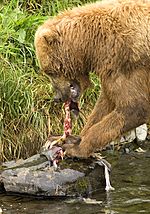
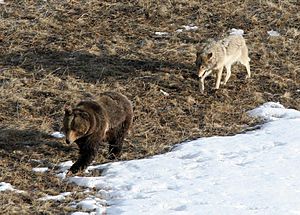
Brown bears are omnivores, meaning they eat both plants and animals. They eat many plant parts, like berries, roots, and sprouts, as well as fungi. They also eat meat, such as fish, insects, and small mammals. Even though they are known for eating meat, most brown bears don't eat a lot of it. Up to 90% of their food energy comes from plants.
Their jaw shape has changed over time to help them eat their varied diet. What they eat changes a lot depending on where they live and what food is available. For example, bears in Yellowstone National Park eat a huge number of moths in the summer. Sometimes they eat as many as 40,000 moths in a day! These insects can provide up to half of their yearly food energy.
In some parts of Russia and Alaska, brown bears mostly eat salmon when the fish swim upstream to lay eggs. The rich nutrition and large amount of salmon explain why bears in these areas grow so big. Brown bears also sometimes hunt large mammals like deer (including elk, moose, and caribou), bighorn sheep, mountain goats, bison, and muskoxen. When they hunt these animals, they usually choose the young ones because they are easier to catch. When hunting, a bear will pin its prey to the ground and then start eating it. Sometimes, bears kill their prey by hitting them with their powerful front paws. This can break the necks and backs of large animals like moose.
They also eat carrion (dead animals). They use their large size to scare away other predators, like wolves, cougars, tigers, and black bears, from their kills.
Brown Bears and Humans
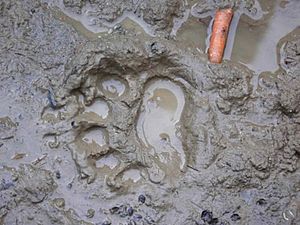
Bears are often drawn to human food sources, like garbage dumps and trash cans. They might go into homes or barns looking for food as people build more homes in bear habitats. In the U.S., bears sometimes kill and eat farm animals. When bears learn that human places mean "food," they become bolder. This increases the chance of humans and bears meeting. They might even return to the same place even if they are moved away.
Moving a bear to a new place has been used to separate bears from humans. But it doesn't solve the problem of the bear learning to link humans with food. Also, putting a bear in an area where other bears live can cause fights and injuries, especially for the weaker bear.
Yellowstone National Park in the western United States is a huge area where grizzly bears (Ursus arctos horribilis) live. Because so many people visit, it's common for humans and bears to meet.
In Europe, one problem is with shepherds. For the past 200 years, many shepherds have stopped using dogs to guard their sheep and goats. Their herds have also grown larger and graze freely. As bears return to their old territories, they might eat livestock. Some shepherds shoot bears, thinking their livelihood is at risk. However, many now know about the money they can get if a bear kills their livestock.
What to Do if You Meet a Bear
On average, there are two deadly bear attacks per year in North America. In Scandinavia, only four known cases of bear encounters have resulted in death since 1902. The two most common reasons for a bear attack are surprise and curiosity. Some bears, like polar bears, are more likely to attack humans for food. American black bears are much less likely to attack.
The Alaska Science Center lists these as the most common reasons for bear attacks:
- Surprise
- Curiosity
- Invading personal space (this includes a mother bear protecting her young)
- Predatory intent (the bear wants to hunt you)
- Hunting a wounded animal
- Defending a dead animal (carcass)
- Being provoked into a charge
Brown bears are naturally aggressive. Unlike smaller black bears, adult brown bears are too big to climb trees to escape danger. So, they stand their ground and fight off attackers. Being aggressive also helps female brown bears protect their cubs and ensure they survive.
Bear Attacks on People
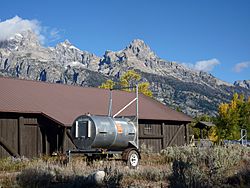
Usually, brown bears do not attack humans right away and often avoid people. However, their mood can be unpredictable. They will attack if they are surprised or feel threatened. Mother bears with cubs cause most injuries and deaths in North America. Bears that are used to humans or associate humans with food can also be dangerous. This is because being around people for a long time makes them lose their natural shyness.
Brown Bears in Culture
Many Native American tribes both respected and feared the brown bear. Some even thought of it as a god. One story says that the black bear was created by the Great Spirit, while the grizzly was created by the Evil Spirit. In Kwakiutl stories, black and brown bears became enemies. This happened when Grizzly Bear Woman killed Black Bear Woman for being lazy. Black Bear Woman's children then killed Grizzly Bear Woman's cubs.
The grizzly bear is the state animal of both Montana and California.
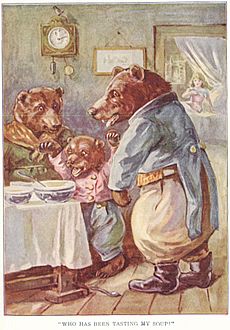
Brown bears often appear in books and stories, especially those for children. "The Brown Bear of Norway" is a Scottish fairy tale about a girl who marries a prince turned into a bear. She helps him become human again through her love. In "Goldilocks and the Three Bears", the three bears are usually shown as brown bears. In Germany, children often hear the fairy tale of Snow White and Rose Red. In this story, a handsome prince is turned into a brown bear. In the United States, parents often read the book Brown Bear, Brown Bear, What Do You See? to young children to teach them colors and animals.
The Russian bear is a common symbol for Russia (and the Soviet Union). The brown bear is also the national animal of Germany and Finland.

The brown bear is the school mascot for the University of California, Los Angeles, the University of California, Berkeley, and the University of Alberta.
The coat of arms of Madrid shows a bear reaching up into a madroño or strawberry tree (Arbutus unedo) to eat its fruit. The Swiss city of Bern's coat of arms also shows a bear. The city's name is thought to come from the German word for bear.
In the town of Prats de Molló in Vallespir, Northern Catalonia, there's an annual "bear festival" (festa de l'ós) in early spring. Locals dress up as bears, cover themselves in soot and oil, and "attack" people watching, trying to get everyone dirty. The festival ends with the ball de l'os (bear dance).
Images for kids
-
An adult female Eurasian brown bear, the most common subspecies.
-
A possible grizzly-black bear hybrid in the Yukon Territory, Canada.
-
A pair of mating brown bears at the Ähtäri Zoo in Ähtäri, Finland.
See also
 In Spanish: Oso pardo para niños
In Spanish: Oso pardo para niños




